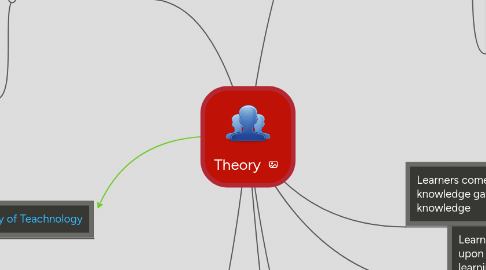
1. Technology Theories
1.1. SCOT (Social Construction of Technology)
1.1.1. Human action shapes technology, no technology shaping humans
1.1.2. Technology can not be understood with out understanding its social implications
1.1.3. SCOT is not only a theory, but also a methodology: it formalizes steps and principles to follow when analyzing the causes of technological failures or successes.
1.1.4. Success of a technology determined by society
1.2. Media Ecology
1.2.1. Study of Media environments
1.2.2. Technology techniques play a role in society and human affairs
1.2.3. opposite of SCOT
1.2.4. preparadigmatic science.
2. Philosophy of Teachnology
2.1. Philosophy of how to use technology as a tool for teaching
2.2. Based of "Philosophy of Teaching"
2.3. Includes the use of technology in the class room to further develop learning and cognitive development
2.4. Technology should only be used to augment learning in the classroom. Should have a direct purpose for learning.
3. TPACK
3.1. Technological Pedagogical Content Knowledge
3.2. The Knowledge teachers need to use technology effectively in the the classroom
3.3. Three forms of Knowldege
3.3.1. PK (Pedagogical Knowledge)
3.3.2. CK (Content Knowledge)
3.3.3. TK (Technological Knowledge)
3.4. Technology will provide content in the best pedagogical way
3.5. Diagram of TPACK: http://www.tpack.org/
4. Learning is constructed, built upon previous knowledge and learning
5. Learners come to situations with previous knowledge gained, and modify and construct new knowledge
6. CONNECTIVISM
6.1. ▪ Learning is a process of connecting specialized nodes or information sources. A learner can exponentially improve their own learning by plugging into an existing network.
6.2. ▪ Learning may reside in non-human appliances. Learning the sense that something is known, can rest in a community, a network, or a database.
6.3. ▪ The capacity to know more is more critical that what is currently known. Knowing where to find information is more important than knowing information.
6.4. ▪ Nurturing and maintaining connections is needed to facilitate learning. Connection making provides far greater returns on effort than simply seeking to understand a single concept.
6.5. ▪ Learning happens in many different ways. Courses, email, communities, conversations, web search, email lists, reading blogs, etc. Courses are not the primary conduit for learning.
6.6. -Connectivism attempts to provide an understanding of how both learners and organizations learn. ▪ Currency (accurate, up-to-date knowledge) is the intent of all connectivist learning.
7. CONSTRUCTIVISM
7.1. If inconsistent understanding occurs, change and accommodation takes place
7.2. Learners apply current understandings, and based on judgment, can modify knowledge
7.3. Emphasizes authentic, challenging projects that include students, teachers and the community
7.4. Learners assume the responsibilities of their own learning, develop metacognitive ability to monitor and direct their learning
8. COGNITIVE LOAD THEORY
8.1. two types of memory: working and long term
8.1.1. Long term memory is where we store our long term memory
8.1.2. working takes in new information and processes it for long term memory
8.2. overload of working memory constricts learning
8.2.1. Teachers must be conscience of amount of work given to students, as it can overload their working memory
